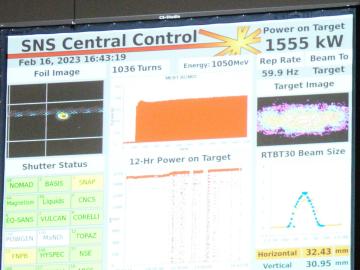
Filter News
Area of Research
- (-) Fusion Energy (9)
- (-) Neutron Science (55)
- Advanced Manufacturing (7)
- Biological Systems (2)
- Biology and Environment (60)
- Building Technologies (2)
- Clean Energy (123)
- Climate and Environmental Systems (2)
- Computational Engineering (2)
- Computer Science (10)
- Electricity and Smart Grid (1)
- Energy Sciences (1)
- Fuel Cycle Science and Technology (1)
- Fusion and Fission (19)
- Isotope Development and Production (1)
- Isotopes (15)
- Materials (131)
- Materials Characterization (2)
- Materials Under Extremes (1)
- National Security (31)
- Nuclear Science and Technology (13)
- Quantum information Science (3)
- Supercomputing (104)
- Transportation Systems (1)
News Topics
- 3-D Printing/Advanced Manufacturing (2)
- Advanced Reactors (4)
- Artificial Intelligence (1)
- Big Data (1)
- Bioenergy (2)
- Biology (1)
- Biomedical (3)
- Biotechnology (1)
- Chemical Sciences (1)
- Clean Water (2)
- Computer Science (2)
- Coronavirus (1)
- Decarbonization (1)
- Energy Storage (4)
- Environment (5)
- Fossil Energy (1)
- Fusion (8)
- High-Performance Computing (1)
- Machine Learning (2)
- Materials (8)
- Materials Science (8)
- Microscopy (1)
- Nanotechnology (2)
- Neutron Science (43)
- Nuclear Energy (7)
- Physics (3)
- Quantum Science (1)
- Space Exploration (1)
- Sustainable Energy (2)
- Transportation (1)
Media Contacts

ORNL's Spallation Neutron Source set a world record when its linear accelerator reached an operating power of 1.55 megawatts, which improves on the facility’s original design capability.

ORNL staff members played prominent roles in reports that won one Distinction award and two Excellence awards in the 2022 Alliance Competition of the Society for Technical Communication. PSD's Karren More and Bruce Moyer participated.

Natural gas furnaces not only heat your home, they also produce a lot of pollution. Even modern high-efficiency condensing furnaces produce significant amounts of corrosive acidic condensation and unhealthy levels of nitrogen oxides

Researchers from Yale University and ORNL collaborated on neutron scattering experiments to study hydrogen atom locations and their effects on iron in a compound similar to those commonly used in industrial catalysts.

The truth is neutron scattering is not important, according to Steve Nagler. The knowledge gained from using it is what’s important

Illustration of the optimized zeolite catalyst, or NbAlS-1, which enables a highly efficient chemical reaction to create butene, a renewable source of energy, without expending high amounts of energy for the conversion. Credit: Jill Hemman, Oak Ridge National Laboratory/U.S. Dept. of Energy

ORNL computer scientist Catherine Schuman returned to her alma mater, Harriman High School, to lead Hour of Code activities and talk to students about her job as a researcher.

As scientists study approaches to best sustain a fusion reactor, a team led by Oak Ridge National Laboratory investigated injecting shattered argon pellets into a super-hot plasma, when needed, to protect the reactor’s interior wall from high-energy runaway electrons.

Kathy McCarthy has been named director of the US ITER Project Office at the Department of Energy’s Oak Ridge National Laboratory, effective March 2020.

An international team of scientists, led by the University of Manchester, has developed a metal-organic framework, or MOF, material


